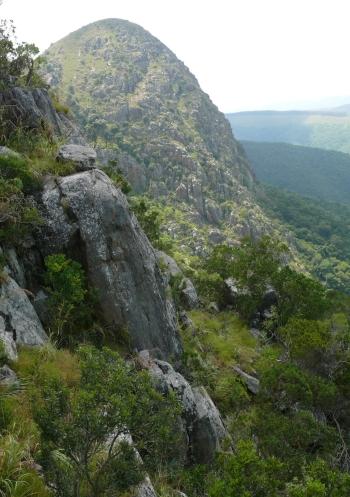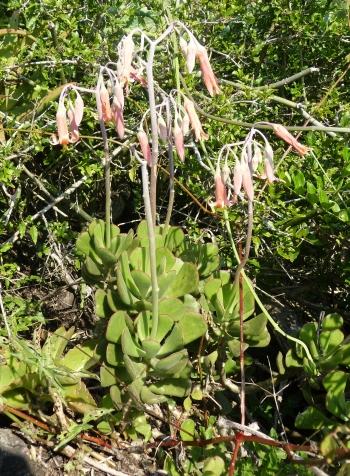Cotyledon egglii
Cotyledon egglii Van Jaarsv.
Family: Crassulaceae
Common names: Barberton pig’s ears (Eng.); Barberton-plakkie (Afr.)
Introduction
A recently named succulent shrublet, recognized by its wedge-shaped (cuneiform), green leaves, sparsely beset with glandular hairs and bearing tubular, orange to dull orange flowers in autumn, that are pollinated by sunbirds. It grows on steep rocky slopes and cliffs in Savanna vegetation of the mountainous terrain of the Barberton Centre of Endemism, Mpumalanga. Cotyledon egglii is easily grown and one of a dozen species of Cotyledon growing in South Africa (Van Jaarsveld & Koutnik 2004).

Description
Description
Cotyledon egglii is an erect, sparsely branched, evergreen, succulent shrublet, up to 500 mm tall. It has fibrous roots. The branches are 8–9 mm in diameter, grey-green, the lower branches up to 15 mm in diameter, with smooth, brownish bark becoming woody with age, the nodes 7–15 mm apart. The leaves are crowded at the ends of the branches, and in opposite pairs or rarely spirally arranged, ascending-spreading, flat, wedge-shaped, compressed, 50–70 × 20–34 mm, the surface dull green and sparsely beset with glandular hairs; the margin of the leaf tips is reddish, slightly undulating, minutely hairy. It has an indistinct petiole, the base cuneate, apex obtuse, mucronate.

The inflorescence is ascending, 220–280 mm long, the peduncle with 2 pairs of bracts. The flowers (corolla) are pendent, dull orange to orange, 30 × 8 mm, the corolla tube is 24 mm long on pendent flower stalks (pedicels), 15–30 mm long. The corolla lobes are lanceolate, 17 × 8 mm, becoming recurved at their tips. The corolla tube, slightly bulges in the middle. Calyx lobes triangular, 5 mm long, 4–5 mm wide; basal glands (squamae) transversely oblong, 1 × 2 mm, yellowish truncate at the apex. The male parts (anthers) 1.5 × 1.5 mm, yellow, exposed for up to 5 mm; stamens 10, in 2 whorls, erect, yellowish green, 35 mm long, fused to the tube in lower third, with a dense tuft of hairs at the point of attachment. Carpels 5, tapering to slender; styles 32–33 mm long. Flowering time is autumn (April–May).
Conservation Status
Status
Cotyledon egglii is not yet assessed for the Red List of South African plants. It is endemic to the serpentines of the Onverwacht Group (Barberton Supergroup), characterised by soils derived from ultramafic lavas that are rich in magnesium and calcium, with high concentrations of heavy metals, and toxic to many plants. Although widespread in its habitat, it is not found in large numbers (Van Jaarsveld 2017).

Distribution and habitat
Distribution description
Cotyledon egglii is only known from the mountains east of Barberton, Mpumalanga, South Africa. It grows in Barberton Serpentine Sourveld (Lowveld Bioregion), which is part of the Savanna Biome (Mucina & Rutherford 2006). Plants grow at altitudes of about 500 to 1 200 m above sea level, in shallow, rocky pockets, on cliffs and steep slopes. At Linga Longa east of Barberton, the plant was growing on south-facing cliffs in full sun or dappled shade. The habitat is shared with other plants, such as Aloe arborescens, A. simii and A. spicata, Cynanchum viminale, Gerbera jamesonii, Haemanthus pauculifolius, Plectranthus hadiensis var. tomentosa and P. verticillatus, Thorncroftia lotterii, Bulbine abyssinica, Crassula expansa subsp. fragilis, C. perfoliata and C. sarcocaulis, Cussonia spicata, Ficus burkei and F. ingens, Schrebera alata, Senecio barbertonicus and Obetia tenax.
At Serenity, the plants were observed on sheer west-facing cliffs and steep, rocky embankments. Here it grows with other succulent plants, which include Aloe spicata, Delosperma lebomboense, Euphorbia evansii, Haemanthus pauculifolius, Pachypodium saundersiae, Plectranthus montanus and Portulacaria afra.
The plants grow in an area which receives rainfall mainly in summer (October to May, southern hemisphere). Rainfall in the habitat is estimated to be 800 to 1 250 mm per annum. The climate is subtropical, with warm winters, and frost in its habitat a rarity. Summers tend to be hot and humid, but with occasional thunder showers.
Derivation of name and historical aspects
History
Cotyledon egglii was named by the author in 2017 in Bradleya, a magazine in Britain solely for succulent plants. C. egglii honours Dr Urs Egglii from the Sukkulenten Sammlung at Zurich, in Switzerland. Dr Egglii has made an extensive contribution towards our knowledge of succulent plants and is responsible for editing of most of the volumes of Handbook of succulent plants (Eggli 2001, 2002, 2003). He has also written several books such as Sukkulenten (Eggli 1994) and the very useful Glossary of botanical terms with special reference to succulent plants (Eggli 1993), on the subject.

Ecology
Ecology
The tubular, orange to dull orange flowers are pollinated by local sunbirds (Nectarina spp.) when the plant flowers during late summer or early winter. After pollination the capsules mature and become erect, opening from the end, and the fine seeds dispersed by wind. The plant has passive resistance - is somewhat brittle and when disturbed and branches fall to the ground will root forming new plants.
Uses
Use
Apart from its horticultural potential, it is not known to be used in any cultural aspects.
Growing Cotyledon egglii
Grow
Cotyledon egglii is easily cultivated, and is a handsome garden plant that grows best in Bushveld and Thicket gardens, but also grows well in gardens of the Western Cape and other Mediterranean-type gardens, provided that frost is not too severe (Van Jaarsveld 2010). It is best on well-drained, north-facing slopes, among rocks. C. egglii also grows well in containers. Plants can be grown in full sun or partial shade.
Cotyledon egglii is easily rooted from stem cuttings grown in situ. Rooting is rapid. It is a slow grower, soon forming ascending shrublets and plants are not shy to flower.
Sow seed preferably during spring or summer in a shady position, in a sandy soil. Cover with a thin layer of sand and keep moist. Best to feed plants with an organic fertilizer (compost or any other liquid fertilizer).
References
- Eggli, U. 1993. Glossary of botanical terms with special reference to succulent plants. British Cactus and Succulent Society.
- Eggli, U. 1994. Sukkulenten. Ulmer, Stuttgart.
- Eggli, U. (ed.) 2001. Illustrated handbook of succulent plants: monocotyledons. Springer, Berlin.
- Eggli, U. (ed). 2001. Illustrated handbook of succulent plants: Dicotyledons. Springer, Berlin.
- Eggli, U. (ed.) 2003. Illustrated handbook of succulent plants: Crassulaceae. Springer, Berlin.
- Morrey, D.R. et al. 1989. Studies on serpentine flora: preliminary analysis of soils and vegetation associated with serpentinite rock formations in the southeastern Transvaal. South African Journal of Botany 55: 171–177.
- Mucina, L. & Rutherford, M.C. (eds) 2006. The vegetation of South Africa, Lesotho and Swaziland. Strelitzia 19. South African National Biodiversity Institute, Pretoria.
- Toelken, H.R. 1985. Crassulaceae. Flora of Southern Africa 14: 1–229.
- Toelken, H.R. 1979. A re-evaluation of the Cotyledon orbiculata Complex. Bothalia 12: 4, 615–620.
- Van Jaarsveld, E.J. 2010. Waterwise gardening in South Africa and Namibia. Struik, Cape Town.
- Van Jaarsveld, E.J. 2017. Cotyledon egglii, a new species from the Barberton region, Mpumalanga, South Africa. Bradleya 35: 179–184.
- Van Jaarsveld, E. & Koutnik, D. 2004. Cotyledon and Tylecodon. Umdaus Press, Hatfield, Pretoria.
- Van Wyk, A.E. & Smith, G.F. 2001. Regions of floristic endemism in South Africa. A review with emphasis on succulents. Umdaus Press, Hatfield, Pretoria
Credits
Ernst van Jaarsveld
Kirstenbosch National Botanical Garden (Retired)
Babylonstoren Farm
Extraordinary Senior Lecturer and Researcher, University of the Western Cape
May 2018
Plant Attributes:
Plant Type: Shrub, Succulent
SA Distribution: Mpumalanga
Soil type: Loam
Flowering season: Autumn
PH: Alkaline, Neutral
Flower colour: Red, Orange
Aspect: Full Sun, Morning Sun (Semi Shade), Afternoon Sun (Semi Shade)
Gardening skill: Easy
Special Features:
Horticultural zones











Rate this article
Article well written and informative
Rate this plant
Is this an interesting plant?
Login to add your Comment
Back to topNot registered yet? Click here to register.